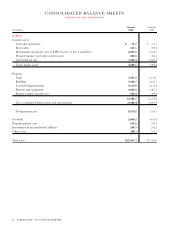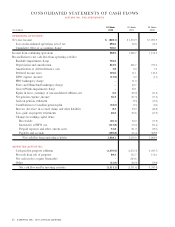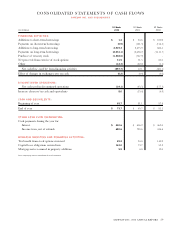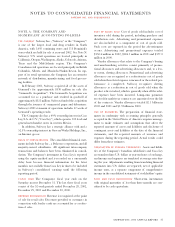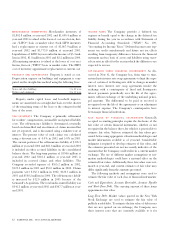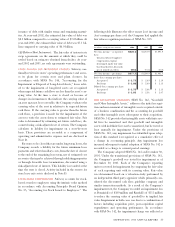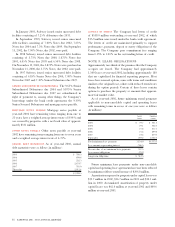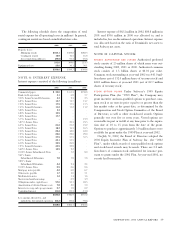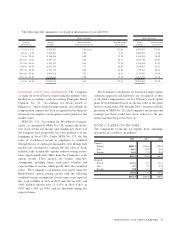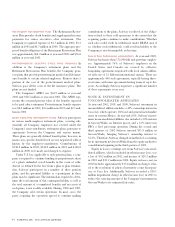Safeway 2002 Annual Report Download - page 36
Download and view the complete annual report
Please find page 36 of the 2002 Safeway annual report below. You can navigate through the pages in the report by either clicking on the pages listed below, or by using the keyword search tool below to find specific information within the annual report.
34 SAFEWAY INC. 2002 ANNUAL REPORT
a cumulative effect of accounting change in the Company’s
statement of operations.
As required by SFAS No. 142, Safeway tested goodwill for
impairment again in the fourth quarter of 2002, which rep-
resents the annual impairment testing date selected by
Safeway. Fair value was determined based on a valuation
study performed by an independent third party appraiser
which primarily used the discounted cash flow method and
guideline company method. As a result of this annual review,
Safeway recorded an impairment charge for Dominick’s
goodwill of $583.8 million, which is recorded as a component
of discontinued operations, and for Randall’s goodwill of
$704.2 million, which is recorded as a component of operat-
ing income. These additional charges reflect declining multi-
ples in the retail grocery industry and operating performance.
SFAS No. 144, “Accounting for the Impairment or Disposal
of Long-Lived Assets,” which supersedes SFAS No. 121,
“Accounting for the Impairment of Long-Lived Assets and for
Long-Lived Assets to be Disposed of,” and the reporting pro-
visions of APB Opinion No. 30, “Reporting the Results of
Operations – Reporting the Effects of Disposal of a Segment
of a Business,” became effective for Safeway on December 30,
2001. In accordance with SFAS No. 144, the Company evalu-
ates the carrying value of the assets in relation to its expected
future cash flows whenever management commits to close or
relocate a store or because of changes in circumstances that
indicate the carrying value of an asset may not be recoverable.
If the carrying value is greater than the future cash flows, a
provision is made for the impairment of the assets to write the
assets down to fair value. Fair value is determined by estimat-
ing net future cash flows, discounted using a risk-adjusted rate
of interest. These provisions are recorded as a component of
operating and administrative expense and are disclosed in
Note D. Adoption of this provision of SFAS No. 144 did not
have a material effect on the Company’s financial statements.
In the fourth quarter of 2002, Safeway decided to sell
Dominick’s and to exit the Chicago market. In accordance
with SFAS No. 144, Dominick’s net assets as of year-end 2002
were written down to their estimated fair market value and
presented as a discontinued operation. See Note N.
In April 2002, the FASB issued SFAS No. 145, “Rescission
of FASB Statements No. 4, 44 and 64, Amendment of FASB
Statement No. 13, and Technical Corrections.” This statement
eliminates extraordinary accounting treatment for a gain or loss
reported on the extinguishment of debt, eliminates inconsisten-
cies in the accounting required for sale-leaseback transactions
and certain lease modifications with similar economic effects,
and amends other existing authoritative pronouncements to
make technical corrections, clarify meanings or describe their
applicability under changed conditions. SFAS No. 145
becomes effective for the Company in the first quarter of 2003.
The Company is currently analyzing the effect that SFAS
No. 145 will have on its financial statements.
In June 2002, the FASB issued SFAS No. 146,
“Accounting for Costs Associated with Exit or Disposal
Activities,” which addresses accounting for restructuring and
similar costs, including store closures. SFAS No. 146 replaces
previous accounting guidance, principally Emerging Issues
Task Force Issue (“EITF”) No. 94-3, “Liability Recognition
for Certain Employee Termination Benefits and Other Costs
to Exit an Activity (including Certain Costs Incurred in a
Restructuring).” Under EITF Issue No. 94-3, a liability for an
exit cost was recognized at the date of the company’s com-
mitment to an exit plan. SFAS No. 146 requires that the lia-
bility for costs associated with an exit or disposal activity be
recognized when the liability is incurred. In accordance with
SFAS No. 146, store lease exit costs are accrued when a store
is closed. SFAS No. 146 also establishes that the liability
should initially be measured and recorded at fair value. SFAS
No. 146 may affect the timing of recognizing future store
closures and restructuring costs, if any, as well as the amounts
recognized. The Company adopted the provisions of SFAS
No. 146 during the third quarter of 2002 for any leased
store-closure activities initiated after June 15, 2002. Adoption
of this standard did not have a material effect on the
Company’s financial statements.
In December 2002, the FASB issued SFAS No. 148,
“Accounting for Stock-Based Compensation – Transition and
Disclosure.” SFAS No. 148 amends SFAS No. 123,
“Accounting for Stock-Based Compensation,” to provide
alternative methods of transition for a voluntary change to
the fair value based method of accounting for stock-based
employee compensation. In addition, SFAS No. 148
amends the disclosure requirements of SFAS No. 123 to
require prominent disclosures in both annual and interim
financial statements about the method of accounting for
stock-based employee compensation and the effect of the
method used on reported results. The provisions of SFAS
No. 148 are effective for financial statements for fiscal years
ending after December 15, 2002. The Company accounts
for stock-based employee compensation arrangements in
accordance with the provisions of Accounting Principles
Board Opinion No. 25, “Accounting for Stock Issued to
Employees,” and complies with the disclosure provisions of
SFAS No. 123 and SFAS No. 148. See Notes A and H.
EITF Issue No. 02-16, “Accounting by a Reseller for
Cash Consideration Received from a Vendor,” provides
that cash consideration received from a vendor is presumed
to be a reduction of the prices of the vendor’s products or




